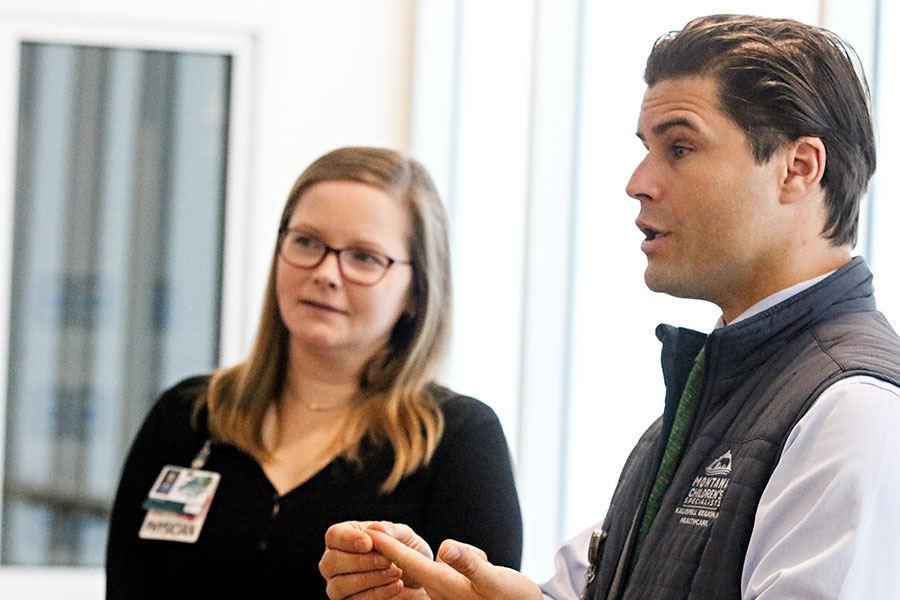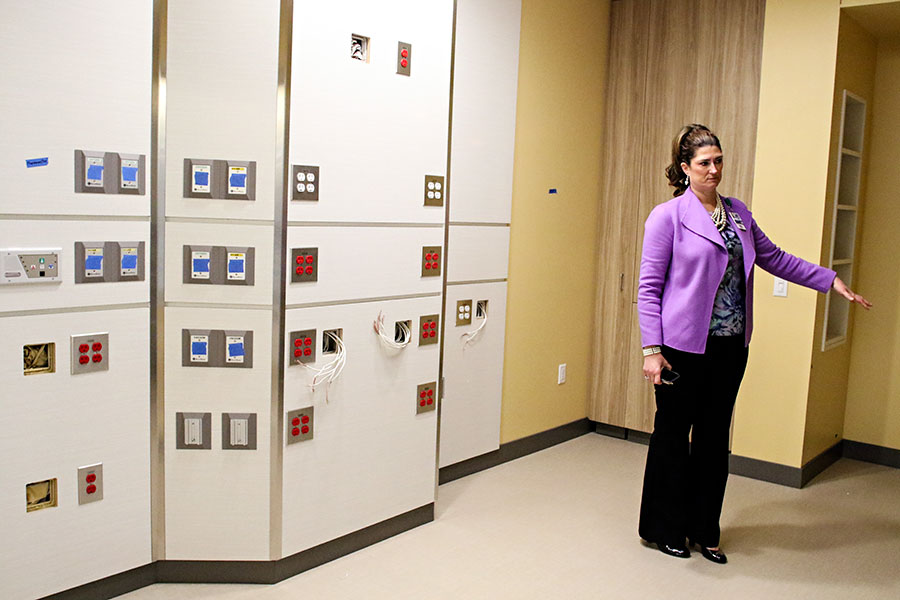Kalispell Regional Healthcare is expected in May to unveil its Montana Children’s Medical Center, an ambitious project years in the making that will house its expansive stable of pediatric specialists and provide an all-in-one regional destination for acute and intensive children’s care, while offering abundant room for future expansion and services.
The center will showcase the breadth of high-level specialized expertise in pediatric care already under KRH’s umbrella. Now these 40-plus subspecialists, some not found anywhere else in Montana, will all be under one roof in a cutting-edge facility with sophisticated technology guided by modern philosophies and design elements aimed at providing holistically complete care for both the child patients and their families.
The first floor will open in May, followed by the second and third floors in later phases in the coming years. In total, the facility encompasses 190,000 square feet. The first phase will house a pediatric unit, pediatric intensive care unit (PICU), Level III neonatal intensive care unit (NICU), rooms outfitted for oncology patients and numerous other spaces for attending to entire families.
“We’re trying to provide state-of-the-art care for kids that they really can’t find anywhere else in Montana,” said Dr. Courtney Stout Paterson, a pediatric hospitalist and the chair of pediatrics at the new center.
Dr. Federico Seifarth, a pediatric surgeon and the center’s medical director, says KRH’s pediatric specialists are coveted around the state, as evidenced by the fact the hospital has for years been deploying them to cities such as Bozeman, Missoula, Great Falls and other areas where those types of care are often underrepresented or nonexistent.
KRH employs the largest group of pediatric specialists in Montana, in fields including oncology, neurosurgery, neonatology, gastroenterology, anesthesiology, radiology, psychiatry, perinatology, cardiology, hematology, endocrinology and more. With all of those doctors onsite, as opposed to locums flown in from places like Seattle or Denver as is common in other cities in Montana, officials say KRH is able to provide comprehensive continuity in care.
“You need all these different elements 24/7 in place to provide this high level of care,” Seifarth said. “That’s what makes us unique.”

“We didn’t build the building and then go recruit all the specialists,” added Teresa Fisher, KRH’s chief nursing executive and the administrator of the children’s center. “They’re already here. That great care is already here and has been here. We needed more space — space specifically designed for kids and their families and very specialized to support the needs of kids and their families.”
The hospital will continue deploying specialists to satellite and outreach locations around Montana, but now patients who need such care, including extended stays and complicated procedures, will have a one-stop destination within state borders.
The center’s overarching premise is to prevent families from needing to leave the state for specialized medical care, which disrupts lives and causes financial stress, and with demand for certain pediatric services tripling in the last couple years, officials say the center’s opening comes at an ideal time. They aren’t worried about attracting sufficient patients.
“This is a service we want to provide for the whole state of Montana, and we’re seeing that trend happen already,” Paterson said. “Kids and families want to come here because of the care we can provide for this state.”
“As that volume has grown,” Fisher added, “there’s been an urgency to create a space for: ‘Where can they sleep? Where can they stay long term?’ As those volumes continue to grow, that’s when we grow into the second and third floor phases.”
A Jan. 11 tour of the facility’s first floor, although unfinished, revealed both the values underlying its design and the flourishes overlaying its construction, which administrators note are intrinsically connected. The architect and engineer is HKS Inc., an international firm headquartered in Dallas, Texas, and the general contractor is Montana-based Swank Enterprises.
For example, the lobby, reflecting the center’s overall Glacier National Park theme, will have artificial trout hanging from the ceiling and a floor patterned to resemble water, on which hologram trout will swim as children stare or chase.

The interior’s décor and colors are specifically designed to identify with kids, alternately calming or playful depending on the unit’s preferred atmosphere, and throughout the facility are kitchenettes, playrooms and outdoor playgrounds, spacious care delivery rooms to accommodate full families, and lounges and family rooms for relaxing or working remotely.
Officials say welcoming environments are soothing to both patients and families who are facing the uneasy experience of a hospital stay, and incorporating such principles has been shown to produce better outcomes. Seifarth said staff visited children’s hospitals across the country to gather ideas.
“We can’t just treat a sole individual,” Seifarth said. “We have to think about the whole family and create a space where they all feel comfortable.”
Along those lines, the children’s center will employ child-life specialists — one of a handful of job descriptions with open positions — who are trained to help children and families navigate a stressful time in their lives.
“It’s a specially trained individual whose job is to try to normalize a child’s experience here as much as possible,” Paterson said. “When they’re used effectively, it’s been shown we use less sedation and patients have better outcomes in a shorter length of stay in the hospital.”
The first phase’s spring opening will offer KRH an opportunity to celebrate an institution that it views as game-changing for health care in Montana and a pivotal point in its evolution as it moves forward after a rocky 2018, during which the hospital grappled with a lawsuit filed by a former financial officer, a $24 million settlement stemming from the litigation and accompanying federal investigation, significant leadership shakeup and unrest among both the public and employees.

Administrators acknowledge the hospital must work to rebuild trust among segments of the public, but note the pediatric center has been in the works for years, before the recent jarring public revelations, and is based on demand that isn’t going away.
“The needs for Montana, the needs for the kids, that doesn’t stop, no matter what external pressures or activities are going on,” Fisher said. “We have the building and we have the specialists. We have the demand.”
Fisher said the first phase is fully funded, meaning the settlement payments or other fallout won’t affect it moving forward. The Montana Facility Finance Authority (MFFA) approved a $100 million bond-financing request for KRH last year that identified roughly $60 million for the children’s center and the rest for other debt and expenses. The MFFA amended the resolution to increase the interest rate and require a portion of the financing to be taxable, a decision that accounted for various factors, including the hospital’s downgraded credit rating and settlement payouts.
Mellody Sharpton, director of communications for KRH, said when the facility opens in May, with the first floor completed and the second and third floors shelled out for future growth, the total spent on the project so far will be $65 million.
Seifarth added that even through last year’s turmoil, the pediatric department grew steadily.
“I think we were able as a pediatric group to focus on what we do independently of what the hospital was going through,” he said. “Of course we acknowledge we are part of the hospital and we have to do anything we can do to increase trust and regain trust in people who have doubts.”
When the doors open, Fisher believes the proof will be crystallized.
“I really think this is something the community will be proud of,” she said.
